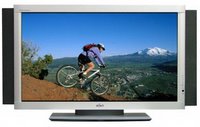Fujitsu P42HHA40US
 The P42HHA40US earned high praise in one important category: It took second place (behind the NEC PX-42XR3A) for displaying high-definition TV. The high score came in part from its bright images and relatively good rendering of detail.
The P42HHA40US earned high praise in one important category: It took second place (behind the NEC PX-42XR3A) for displaying high-definition TV. The high score came in part from its bright images and relatively good rendering of detail.But its color performance was subpar, ranking near the bottom. Like other poor performers, such as the Sony KDE-42XS955, the Fujitsu was weakest in reds. What should have been a candy-apple-colored sports car in one HDTV segment was instead the hue of a tomato-cream sauce. And in high-def clips from a talk show and a sitcom, faces looked rather pale. Adjusting the overall color level, and even adjusting the primary colors individually (which this TV allows), failed to produce saturated red tones.
Making those or any other adjustments can be quite a chore because of the Fujitsu's incomprehensible menus. The TV has, for example, two different contrast controls, one called "Signal Contrast" and the other "Drive Contrast." Neither the on-screen menus nor the manual offers a clear description of how the two differ. (After contacting Fujitsu, we learned that "Signal Contrast" corresponds to the regular contrast control on other TVs--the one we needed for our calibration. We're still not positive what the other one does.)
Like the NEC PX-42XR3A, the Fujitsu is a plain monitor, without a television tuner or speakers (though a pair of 20-watt units sells for a reasonable $199). One notable bonus over the NEC is that the Fujitsu has an HDMI port, instead of a DVI connection. But that feature isn't worth an extra $2000--the difference between the two products' street prices.
Upshot: This panel has pretty good image quality; but uneven performance, awkward design, and a relatively high price keep it well out of the running.
Source: pcworld





